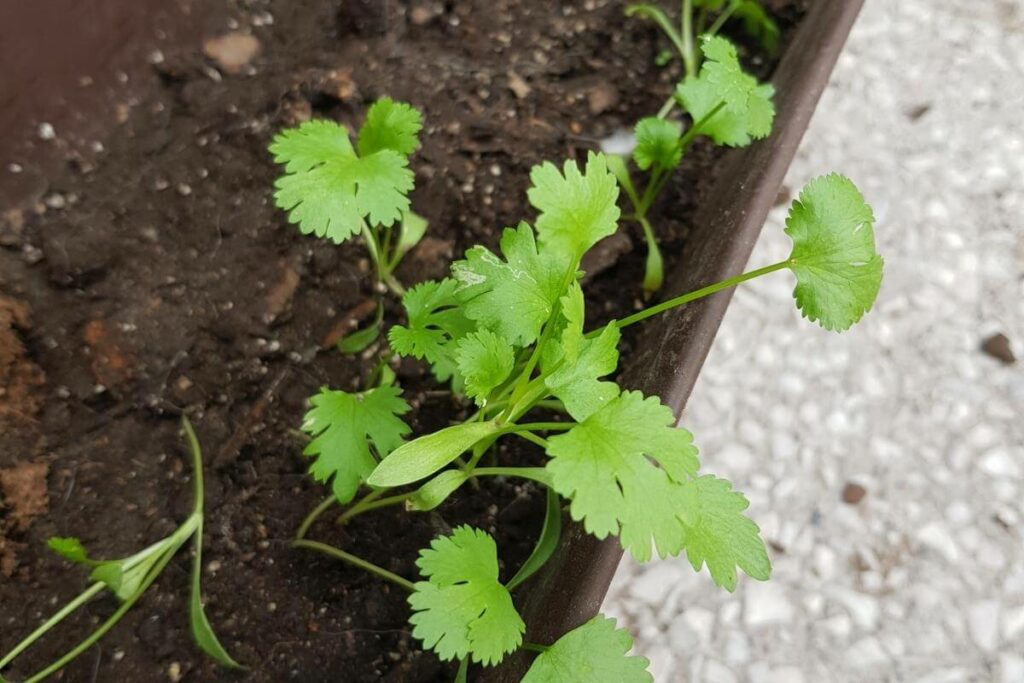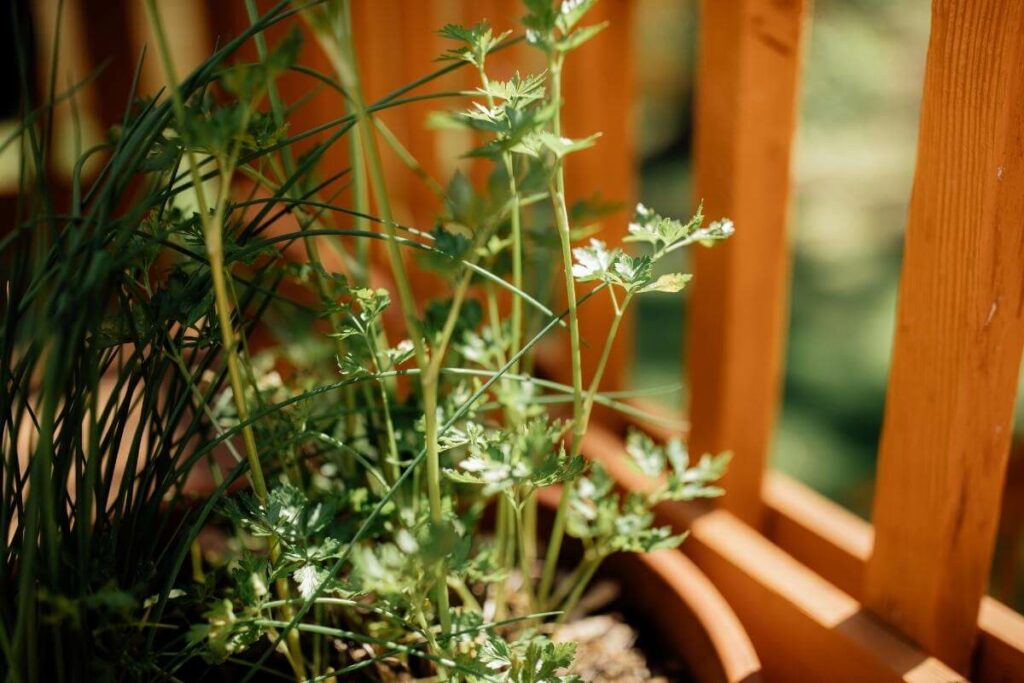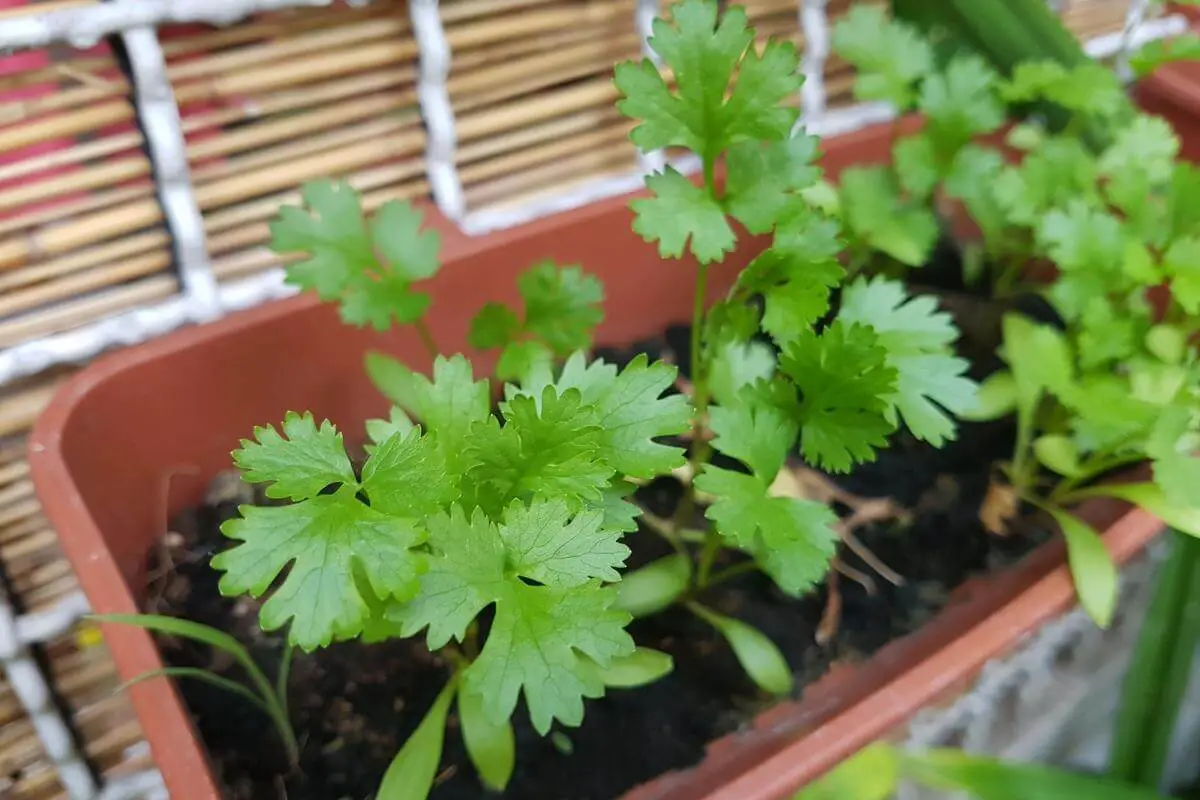Cilantro (also known as coriander) is a delicious herb full of healthy things such as manganese, magnesium, and Vitamin A, C, and K.
It is also believed to help lower blood pressure. The annual is fairly easy to grow, yet fussy.
It can start changing colors for seemingly inexplicable reasons.
For example, why do cilantro stems turn purple?
Cilantro stems turn purple when it is getting ready to bolt. Bolting is when the plant is gearing up to make seeds by first producing flowers. Once it has gone to seed, it will die. Cilantro will bolt early when it is stressed by too much heat or unfavorable conditions to its soil or water.
Cilantro seeds do take a few weeks to germinate, but they are pretty easy to grow. But once the herb gets a few leaves, it becomes like Goldilocks.
It likes to be sunny and warm, but not hot or cold. It wants lots of room for its roots, soil that is damp but not soggy or dry.
The moment any of this goes awry, it believes the plant apocalypse is nigh and bolts.
Common Reasons Why Cilantro Stems Turn Purple
Cilantro is an annual, so eventually, its end will come.
But sometimes, it bolts well before its time, and purple stems are one of the tell-tale signs.

Here are the common reasons why cilantro stems turn purple, and its leaves might change color too.
Compacted Soil Can Make Cilantro Bolt
Cilantro does not like its soil to be compacted.
This easily happens from regular watering, especially in containers. As the soil tightens around the plant’s roots, it freaks out and decides it is going to suffocate.
Usually, the first sign of this is an alteration in the color of some of the leaves before stems go purple.
As soon as you realize that the soil is becoming compacted or a few leaves changing from their usual green, try to loosen the top layer of soil gently.
Carefully, so you don’t disturb the roots, use your finger or a chopstick to fluff up the top half-inch of its soil. This will allow better drainage and more oxygen to reach its roots.
Direct Sunlight On A Hot Day Can Make Cilantro Bolt
Cilantro does not enjoy being in the shade all day.
It is delighted by the sun unless it is hot. So while cilantro will happily grow in temperatures as warm as 85 degrees (29 C), it will bolt if that 85 is shining right on it.
This is why many people in warmer climates grow it in spring or autumn, avoiding frost. Also, if you are using grow lights, avoid the intense settings and keep it a good 4 inches away.
While cilantro prefers to be in the ground, putting it in a roomy pot can allow you to move it into the shade on hot days.
You could also construct some temporary covers with shade cloth to place over them on particularly warm days.
If you are lucky to have a spot that gets plenty of morning and late-afternoon sun but is shady at the hottest parts of the day, perfect.
Have You Noticed: Early signs of cilantro getting too much hot sun are crispy leaves or leaves turning from bright green to a lighter shade.
The Wrong Soil pH Can Make Cilantro Bolt
Cilantro’s favorite soil is slightly acidic.
Its perfect happy place is a pH of 6.5-6.8. That said, it is relatively tolerant of soil out of this range so long as it is well-drained and has plenty of nutrients.

But if the pH gets really out of whack, it will complain. Before the stems turn purple, the leaves will generally start to discolor.
If you suspect it is your soil’s pH, you can obtain and pH kit and check:
- If it doesn’t have enough acid (below 6), then you can fix it with a bit of limestone.
- If it is too alkaline (above 7), this can be amended with some citric acid.
Just don’t pour it directly onto the soil; mix it with some water first.
Overwatering Can Make Cilantro Bolt
Cilantro doesn’t like to be in boggy soil or overwatered.
Too much water makes it difficult for the herb to get enough oxygen that wilts and discolors leaves, and can cause stunted growth.
If you see that your cilantro is too wet, try to avoid repotting, as this too can make it grumpy. However, if you absolutely must, do so gently.
Instead: Try to let the plant dry out until the soil is simply moist. You can sometimes speed this along by loosening the soil. If a storm has swept in, try to moving outside containers of cilantro to a sheltered spot.
Underwatering Can Make Cilantro Bolt
Cilantro has a very short temper when it comes to dry soil.
Its leaves will go yellow, and it bolts, often with those tell-tale signs of purple stems.
On very warm days, you might find you need to water it multiple times.
Moving it to a shady spot or giving it a shade tent will help it from drying out so quickly.
Can You Stop Cilantro From Bolting?
You can’t really stop cilantro from bolting once you’ve reached the flowering stage.
However, cutting off the purple stems and discolored leaves might delay the full feathery leaves and white flower stage a little bit.

Also, the seeds, once they are brown and ready to harvest, are an excellent spice.
Their musky orbs can be ground up and used in plenty of dishes, including curries.
What Varieties of Cilantro Are Slow to Bolt?
There are several varieties of cilantro.
Some do taste a bit different, but that can be part of the fun.
Varieties of more familiar tasting cilantro that are slower to bolt are:
- Long Standing
- Leisure
- Jantar
Other options are Vietnamese cilantro and Culantro (from Egypt). The leaves look very different from the common varieties sold in the United States.
Rather than looking like flat-leaf parsley, the Vietnamese have long, smooth leaves. Culantro enjoys shade and is sometimes sold as Spiny Coriander, thanks to its long and spiny leaves.
Conclusion
Purple stems or discolored leave on cilantro are a sign the plant is stressed and is gearing up to bolt.
To delay bolting, try to keep it in ideal warm but not hot conditions, with damp soil, but not waterlogged.
Remember, it likes plenty of room for its roots and fluffed topsoil.
Also Useful
- Can You Overwater Parsley? Water Requirements
- Is An Apple A Fruit Or Vegetable? (Quick answer)
- How to Get Big Mint Leaves?
